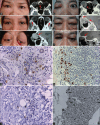Recurrence of Idiopathic Orbital Inflammation: An 11-year Retrospective Study
- PMID: 39006932
- PMCID: PMC11238927
- DOI: 10.4103/meajo.meajo_225_21
Recurrence of Idiopathic Orbital Inflammation: An 11-year Retrospective Study
Abstract
Purpose: The high recurrence rate of idiopathic orbital inflammation (IOI) has been reported. This study aims to determine existing predictive factors for the recurrence of IOI.
Methods: This was an 11-year retrospective study with at least a 12-month follow-up. Fifty patients with biopsy-proven IOI admitted between 2006 and 2017 at our tertiary hospital were observed. We compared the clinical characteristics, histopathological profile, and biomarker expressions (mast cell, immunoglobulin G4, tumor necrosis factor-alpha, and transforming growth factor-beta) of 16 patients with recurrence (Group I) and 34 patients with no recurrence (Group II). Statistical comparison and multivariate analysis were performed to establish the predictive factors.
Results: We discovered five recurrence predictive factors: presentation of proptosis (odds ratio [OR] 4.96, 95% confidence interval [CI] 1.36-18.03), visual impairment (OR 15, 95% CI 1.58-142.72), extraocular muscle (EOM) restriction (OR 3.86, 95% CI 1.07-13.94), nonanterior involvement (OR 7.94, 95% CI 1.88-33.5), and corticosteroid (CS) alone treatment (OR 7.20, 95% CI 1.87-27.8). On multivariate analysis, nonanterior involvement and CS alone treatment were validated as predictive factors (area under the curve = 0.807 [95% CI 0.69-0.92]). Histopathological profile and biomarker expressions were not associated with recurrence. However, there was a 22-fold higher recurrence risk for granulomatous-type patients given CS alone treatment.
Conclusion: Unlike the five clinical characteristics mentioned, both histopathology and biomarker variables were not associated with recurrence. CS alone treatment for patients with nonanterior involvement or granulomatous type is proven to increase the risk of recurrence. Therefore, we suggest not giving CS without any combination treatment with other modalities for this group of patients.
Keywords: Idiopathic orbital inflammation; immunoglobulin G4; transforming growth factor-beta; tumor necrosis factor-alpha.
Copyright: © 2024 Middle East African Journal of Ophthalmology.
Conflict of interest statement
There are no conflicts of interest.
Figures


Similar articles
-
Factors associated with multiple recurrences of nonspecific orbital inflammation aka orbital pseudotumor.Int Ophthalmol. 2018 Aug;38(4):1485-1495. doi: 10.1007/s10792-017-0610-7. Epub 2017 Jun 20. Int Ophthalmol. 2018. PMID: 28634929
-
Pediatric Idiopathic Orbital Inflammation: Clinical Features of 30 Cases.Ophthalmic Plast Reconstr Surg. 2016 Jul-Aug;32(4):270-4. doi: 10.1097/IOP.0000000000000494. Ophthalmic Plast Reconstr Surg. 2016. PMID: 27337659
-
Features associated with recurrence of idiopathic orbital inflammatory pseudotumor.Yan Ke Xue Bao. 2007 Mar;23(1):58-64. Yan Ke Xue Bao. 2007. PMID: 17444043
-
Relapsing migratory idiopathic orbital inflammation: six new cases and review of the literature.Br J Ophthalmol. 2012 Feb;96(2):276-80. doi: 10.1136/bjo.2010.191866. Epub 2011 Apr 27. Br J Ophthalmol. 2012. PMID: 21527417 Review.
-
Long-term follow up of systemic rituximab therapy as first-line and salvage therapy for idiopathic orbital inflammation and review of the literature.Orbit. 2022 Jun;41(3):297-304. doi: 10.1080/01676830.2021.1874424. Epub 2021 Jan 21. Orbit. 2022. PMID: 33478316 Review.
References
-
- Braich PS, Kuriakose RK, Khokhar NS, Donaldson JC, McCulley TJ. Factors associated with multiple recurrences of nonspecific orbital inflammation aka orbital pseudotumor. Int Ophthalmol. 2018;38:1485–95. - PubMed
-
- Young SM, Chan AS, Jajeh IA, Shen S, Seah LL, Choo CT, et al. Clinical features and treatment outcomes of orbital inflammatory disease in Singapore: A 10-year clinicopathologic review. Ophthalmic Plast Reconstr Surg. 2017;33:182–8. - PubMed
-
- Mokhtech M, Nurkic S, Morris CG, Mendenhall NP, Mendenhall WM. Radiotherapy for orbital pseudotumor: The university of Florida experience. Cancer Invest. 2018;36:330–7. - PubMed
-
- Espinoza GM. Orbital inflammatory pseudotumors: Etiology, differential diagnosis, and management. Curr Rheumatol Rep. 2010;12:443–7. - PubMed
MeSH terms
LinkOut - more resources
Full Text Sources

